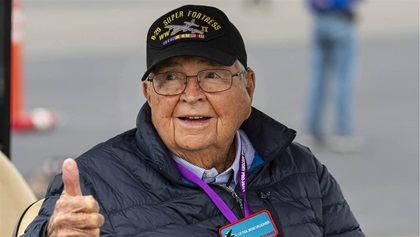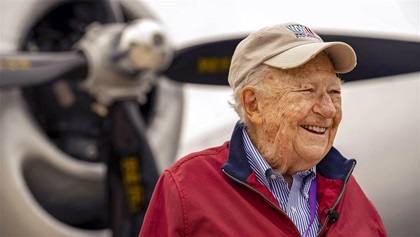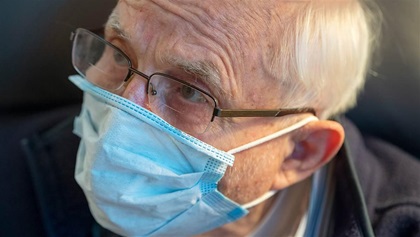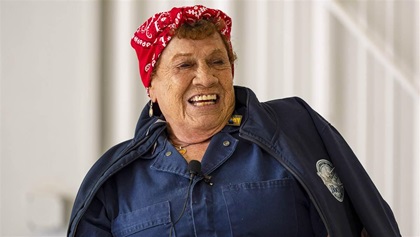The best flyover you never saw
Scrubbed Capitol flyover still honors World War II veterans
By Mike Collins and David Tulis
We must have more ships, more guns, more planes—more of everything. And this can be accomplished only if we discard the notion of ‘business as usual,’” President Franklin D. Roosevelt said in his fireside chat the evening of December 29, 1940, nearly a year before the United States was drawn into World War II.
Arsenal of Democracy




Although he called it “a talk on national security,” Roosevelt spoke about preparations for war, only 22 years after the end of the First World War. The United States was providing military aid to Great Britain and China. He reiterated his objective of avoiding military action but mobilization for World War II already was underway; in September 1940 Congress had enacted the first peacetime draft in U.S. history. On December 8, 1941, one day after the attack on Pearl Harbor, Congress declared war on Japan. Three days later, the nation also was at war with Hitler’s Germany.
The Arsenal of Democracy: World War II Victory Capitol Flyover on May 8, 2015, which marked the seventieth anniversary of the war’s end, was organized by the General Aviation Manufacturers Association, National Air Traffic Controllers Association, International Council of Air Shows, and Commemorative Air Force to thank and honor World War II veterans, educate the public about the history of World War II, and pay tribute to the contributions made by Americans on the home front during the war. It was so well received that a second flyover, commemorating the seventy-fifth anniversary, was planned for May 8, 2020. Postponed because of the global coronavirus pandemic, conditions had improved by summer to the point organizers felt the event could be held safely in September with appropriate social distancing—but without any large gathering of veterans on the National Mall in downtown Washington, D.C., which was a hallmark of the 2015 event.
Some 60 World War II aircraft gathered at airports in Culpeper and Manassas, Virginia, for the rescheduled September 25 event, which was scrubbed because of low clouds. So was the only alternate date of September 26.
Despite the disappointment of cancellation following postponements, several World War II veterans were recognized for their contributions to the war effort. Three would have been passengers on the flight over Washington, D.C.
 Retired U.S. Air Force Lt. Col. Robert Vaucher, who led more than 500 Boeing B–29 Superfortresses over Tokyo Bay during the signing of the Japanese surrender, was tapped as honorary air boss for the 2020 Arsenal of Democracy. The 101-year-old said he would admonish pilots to “get in line and stay in line” during the mission, which was to follow the Potomac River before taking a left turn at the Lincoln Memorial and proceeding along the National Mall.
Retired U.S. Air Force Lt. Col. Robert Vaucher, who led more than 500 Boeing B–29 Superfortresses over Tokyo Bay during the signing of the Japanese surrender, was tapped as honorary air boss for the 2020 Arsenal of Democracy. The 101-year-old said he would admonish pilots to “get in line and stay in line” during the mission, which was to follow the Potomac River before taking a left turn at the Lincoln Memorial and proceeding along the National Mall.
Organizing the 525-ship show of force in 1945 was a daunting assignment because Gen. Douglas MacArthur demanded pilots appear overhead the USS Missouri “at precisely 9:04 a.m.” on September 2, recalled Vaucher, tasked with rallying the aircraft from about 100 miles away after U.S. Army Air Forces “Gen. [Curtis] LeMay vowed to ‘put every B–29 in the area over the bay’” to satisfy MacArthur’s wish. “It was the feat of my lifetime to make it happen,” Vaucher said. “It stuck with me for a long time.”
He flew 117 combat missions in the Panama, China-Burma-India, and Central Pacific theaters, earning two Distinguished Flying Crosses and five Air Medals, among other commendations.
 When 17-year-old Paul Hilliard was delivering newspapers to his Wisconsin neighbors during 1942, he became so infatuated with headlines about the Douglas SBD Dauntless dive bomber’s role in the Battle of Midway that he persuaded his mother to sign him up for active duty. He tipped his cap to the U.S. Marine Corps for training him to operate the Dauntless’s radio and guns.
When 17-year-old Paul Hilliard was delivering newspapers to his Wisconsin neighbors during 1942, he became so infatuated with headlines about the Douglas SBD Dauntless dive bomber’s role in the Battle of Midway that he persuaded his mother to sign him up for active duty. He tipped his cap to the U.S. Marine Corps for training him to operate the Dauntless’s radio and guns.
“The dives lasted about 30 seconds, but we searched for hours” before locating targets. The exercises stretched his concentration—and sometimes his bladder—and the 95-year-old still marvels at the airplane’s ability to attain a near-vertical, 80-degree dive and strike a moving target.
After the war, Hilliard was bitten by the aviation bug and earned instrument and multiengine ratings. He also became involved in the National World War II Museum in New Orleans where, as a trustee and then board chairman, he helped guide it through a $400 million expansion.
 Art Kahley, who turned 98 the week before the rescheduled Arsenal of Democracy event in September, served in the Pacific more than two years as an antiaircraft gunner. His son, David, a North American T–6 pilot who participated in the 2015 Capitol flyover and was set to do so again in 2020, arranged a ride to the National Mall so his parents could witness the aerial display. But the continuing coronavirus pandemic cancelled those plans.
Art Kahley, who turned 98 the week before the rescheduled Arsenal of Democracy event in September, served in the Pacific more than two years as an antiaircraft gunner. His son, David, a North American T–6 pilot who participated in the 2015 Capitol flyover and was set to do so again in 2020, arranged a ride to the National Mall so his parents could witness the aerial display. But the continuing coronavirus pandemic cancelled those plans.
So, in near-perfect weather on September 23, David Kahley and three other T–6 pilots brought the Arsenal of Democracy to him.
Smoke on, the flight of four flew over Art and Mildred Kahley’s home in York, Pennsylvania. “We went into four different formations and tried to do that all in sight of him,” David Kahley explained, acknowledging that the tight formation turns were tough on his wingmen.
Art Kahley had driven his son 25 miles each way to an airport for flying lessons, because David did not yet have a driver’s license; Art said what he and Mildred paid for the lessons was a good investment. “He loved flying,” Kahley recalled. “All of the planes that he had, I was his first passenger.”
Kahley said he never shot down an enemy airplane. “We had control of the skies” and the airstrip he defended was never attacked, he explained. His son “got a kick out of” the fact his dad was an antiaircraft gunner, he added.
The Kahleys and a small number of friends appreciated their personal flyover. “It was fun for us. We stood up and cheered. It was exciting,” he said.
And none realized that they had just experienced what would be the only, albeit unofficial, Arsenal of Democracy flyover in 2020. “It was perfect weather. The sky was so blue, and the next day it was very cloudy and bad,” Kahley said. “His flyover here was the most [people] he flew over. Down there [in Washington, D.C.] they cancelled it.”
 Connie Palacioz was 17 and working in a laundromat pressing military uniforms for 25 cents an hour when she learned she could earn three times as much helping to build B–29 Superfortresses on Boeing’s Wichita, Kansas, assembly line. She took classes for two weeks to learn the art of riveting and soon was transferred to the factory floor—first as a rivet bucker working the back side of the metal fasteners, and then as a riveter.
Connie Palacioz was 17 and working in a laundromat pressing military uniforms for 25 cents an hour when she learned she could earn three times as much helping to build B–29 Superfortresses on Boeing’s Wichita, Kansas, assembly line. She took classes for two weeks to learn the art of riveting and soon was transferred to the factory floor—first as a rivet bucker working the back side of the metal fasteners, and then as a riveter.
As an original “Rosie the Riveter,” she befriended a Black female coworker, Jerry Wordan, when few others would, forming a riveting-bucking team that continued through the war effort. “I riveted 1,644 B–29 nose sections, including Doc ,” recalled Palacioz. Decades after the war, she volunteered to help restore that B–29. She said she was honored to learn that “only seven rivets were missing” from her section when the Superfortress was resurrected following years of service, then decades of neglect in the Mojave Desert.
She would have flown aboard her baby, Doc.
Email [email protected]
Planning Stage






